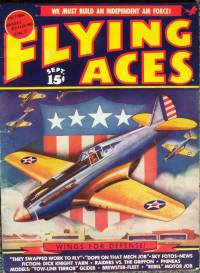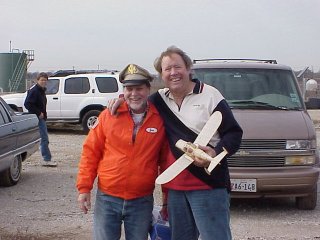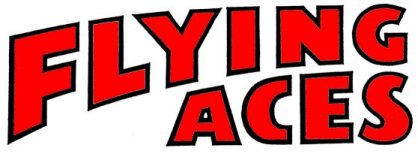Who Are The FLYING ACES?
Do you remember a time when life was just a little slower and a bit more relaxed? You can recapture a time like this by participating in this hobby. Trade in your TV sets and video games for something constructive and very satisfying. You are building something with your own hands, a machine capable of working with the same physical laws of this Earth as the fabric, wood, and wire airplanes of World War I all the way to today's modern airliners, and everything in between. In this hobby, your airplane is as true and honest about it's behavior as anything you'll ever experience. It cannot lie to you nor violate these laws of nature. You must learn how it wants to behave in the air and adjust yourself and the machine accordingly.

Rubber powered aircraft are considered freeflight models, in that there are no control systems for you to use while it is flying. The airplane must be trimmed (adjusted) in such a way that it flies on it's own, preferably in nice lazy circles in the sky. You and the others around you become spectators to the majesty of flight as soon as it is released into the air. Those of us who are incurable, rejoice at the site of a well trimmed model in steady flight. The models fly from 30 seconds up to two minutes and in some cases will actually fly away! These flight times seem trivial until you experience it. You must learn to give up that urge to control things in your life when becoming a freeflight model builder.
Rubber models are constructed using the traditional stick and tissue methods developed in the 20's and 30's. There are some new advances in some of the materials and techniques, but the time honored methods are very much the basis of how they are built. These airplanes are very light, weighing in at just ounces or grams. The word "pound" is not found in our vocabulary except to describe a physical act wished upon an uncooperative airplane. Balsa wood is the chief ingredient found in "stick" and tissue is a very thin, uniform paper.
 The FLYING ACES Club takes its name
from a magazine popular with kids back in the 30’s and 40’s.
This magazine was a collection of aviation articles, pictures, stories,
and modeling activities. Many of the stories were fictional but also
included current information about what was going on in aviation. The
Pre-war stuff is really interesting to read as the magazine attempted
to assess our air power and the capabilities of our enemies. The old
magazines are collected all over the world and from time to time you
can find them at contests and anywhere rubber modelers get together.
In those days, the world was fascinated by aviation. It was called the
“Golden Age” of aviation due in large part to all of the
pioneering efforts in aircraft design, construction, and performance.
Aircraft were transitioning from the stick, fabric and wire biplanes
of World War I to the slick all-metal monoplanes of World War II. During
this transition, some of the most interesting and beautiful airplanes
were built and aviators were some of the most adventurous and daredevil
people, as evidenced by their incredible journeys and feats. It was
the aviation companies and the military that sponsored model building
as a way to support this fascination and encourage young people to pursue
careers in aviation at a time when the industry was blossoming. Models
were powered by rubber motors in those days because gas engines were
expensive and rare. This problem was worse during the Second World War
when materials became scarce and were needed for the war effort. In
order for a rubber powered airplane to fly with any degree of success,
they had to be built very light. Hence the construction technique of
a framework using thin pieces of balsa, spruce, and bamboo (stick) covered
with a light paper made of wood or bamboo (tissue) made taught by applying
water, dope (a type of paint), or even banana oil. So popular was this
activity that kits and model supplies could be found in most drug and
department stores.
The FLYING ACES Club takes its name
from a magazine popular with kids back in the 30’s and 40’s.
This magazine was a collection of aviation articles, pictures, stories,
and modeling activities. Many of the stories were fictional but also
included current information about what was going on in aviation. The
Pre-war stuff is really interesting to read as the magazine attempted
to assess our air power and the capabilities of our enemies. The old
magazines are collected all over the world and from time to time you
can find them at contests and anywhere rubber modelers get together.
In those days, the world was fascinated by aviation. It was called the
“Golden Age” of aviation due in large part to all of the
pioneering efforts in aircraft design, construction, and performance.
Aircraft were transitioning from the stick, fabric and wire biplanes
of World War I to the slick all-metal monoplanes of World War II. During
this transition, some of the most interesting and beautiful airplanes
were built and aviators were some of the most adventurous and daredevil
people, as evidenced by their incredible journeys and feats. It was
the aviation companies and the military that sponsored model building
as a way to support this fascination and encourage young people to pursue
careers in aviation at a time when the industry was blossoming. Models
were powered by rubber motors in those days because gas engines were
expensive and rare. This problem was worse during the Second World War
when materials became scarce and were needed for the war effort. In
order for a rubber powered airplane to fly with any degree of success,
they had to be built very light. Hence the construction technique of
a framework using thin pieces of balsa, spruce, and bamboo (stick) covered
with a light paper made of wood or bamboo (tissue) made taught by applying
water, dope (a type of paint), or even banana oil. So popular was this
activity that kits and model supplies could be found in most drug and
department stores.
 Many
of the modelers who grew up in the 1930's are still active and they
keep the stick and tissue tradition alive by building, flying and promoting
these models. Every one is an avid aircraft ENTHUSIAST
and can identify just about any aircraft known. Many of the classes
of models flown in the Flying Aces events are derived from these early
designs. Not much has changed in the way these models are built or flown
although there have been improvements in covering materials, adhesives,
and especially the rubber which we power them with. The Flying Aces
club boasts a membership of more than 1500 people in
the US and worldwide. They are locally organized into squadrons so they
can meet, fly, and hold contests at their respective field. The local
squadrons are more interested in coming together for flying and fun
and are not too wrapped up on protocol. Members of the Flying
Aces are encouraged to also become members of the Academy
of Model Aeronautics (AMA), a nationally known modeling
association with over a million members. You will be required to be
a member if you fly in some contests, particularly the National Flying
Aces events (Nats) and any AMA sanctioned event. The AMA
provides a larger voice to support our hobby and also provides group
liability insurance coverage for any possible accident incurred while
flying. Included with your AMA membership is a monthly
magazine highlighting the national activities and local events.
Many
of the modelers who grew up in the 1930's are still active and they
keep the stick and tissue tradition alive by building, flying and promoting
these models. Every one is an avid aircraft ENTHUSIAST
and can identify just about any aircraft known. Many of the classes
of models flown in the Flying Aces events are derived from these early
designs. Not much has changed in the way these models are built or flown
although there have been improvements in covering materials, adhesives,
and especially the rubber which we power them with. The Flying Aces
club boasts a membership of more than 1500 people in
the US and worldwide. They are locally organized into squadrons so they
can meet, fly, and hold contests at their respective field. The local
squadrons are more interested in coming together for flying and fun
and are not too wrapped up on protocol. Members of the Flying
Aces are encouraged to also become members of the Academy
of Model Aeronautics (AMA), a nationally known modeling
association with over a million members. You will be required to be
a member if you fly in some contests, particularly the National Flying
Aces events (Nats) and any AMA sanctioned event. The AMA
provides a larger voice to support our hobby and also provides group
liability insurance coverage for any possible accident incurred while
flying. Included with your AMA membership is a monthly
magazine highlighting the national activities and local events.
 Headquarters
of the Flying Aces publishes one main newsletter titled “Flying
Aces Club News”. This newsletter contains announcements of upcoming
contests, results of contests, and technical information. In addition,
plans are included for building models submitted by FAC members. Most
local squadrons published their own newsletter highlighting local events,
technical information, and (of course) more plans. Many members join
other squadrons to get their newsletters because they are informative
and contain more plans (in case you haven’t caught on by now,
we can’t get enough plans or kits). A year's membership in the
FAC that includes a subscription to the newsletter costs $18.00 per
year.
Headquarters
of the Flying Aces publishes one main newsletter titled “Flying
Aces Club News”. This newsletter contains announcements of upcoming
contests, results of contests, and technical information. In addition,
plans are included for building models submitted by FAC members. Most
local squadrons published their own newsletter highlighting local events,
technical information, and (of course) more plans. Many members join
other squadrons to get their newsletters because they are informative
and contain more plans (in case you haven’t caught on by now,
we can’t get enough plans or kits). A year's membership in the
FAC that includes a subscription to the newsletter costs $18.00 per
year.
To sign up write to:
Flying Aces Club - General
Headquarters (GHQ)
Lin Reichel
3301 Cindy Lane
Erie, PA 16506
Fortunately, they are attracting some of the younger population at a rate that will probably keep the art and technology alive for some time. You can join as many squadrons as you want.
